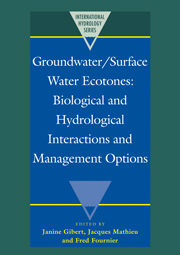Book contents
- Frontmatter
- Contents
- List of authors
- Preface
- I INTRODUCTION
- II FUNCTION OF GROUNDWATER / SURFACE WATER INTERFACES
- 2 Ecotonal animal assemblages; their interest for groundwater studies
- 3 Stochasticity in resource utilization by a larval chironomidae (diptera) community in the bed sediments of a gravel stream
- 4 Temporal and spatial dynamics of meiofaunal assemblages in the hyporheic interstitial of a gravel stream
- 5 Interstitial fauna along an epigean-hypogean gradient in a Rocky Mountain river
- 6 Filter effect of karstic spring ecotones on the population structure of the hypogean amphipod Niphargus virei
- 7 Community respiration in the hyporheic zone of a riffle-pool sequence
- 8 Diversity, connectivity and variability of littoral, surface water ecotones in three side arms of the Szigetköz region (Danube, Hungary)
- 9 Seasonal dynamics and storage of particulate organic matter within bed sediment of three streams with contrasted riparian vegetation and morphology
- 10 Bedsediments: Protein and POM content (RITRODAT-Lunz study area, Austria)
- 11 Dynamics and vertical distribution of particulate organic matter in river bed sediments (Morava River, Czech Republic)
- 12 Surface water/groundwater/forest alluvial ecosystems: functioning of interfaces. The case of the Rhine floodplain in Alsace (France)
- 13 Modelling of hydrological processes in a floodplain wetland
- 14 Contribution to the groundwater hydrology of the Amboseli ecosystem, Kenya
- 15 The role of hydrology in defining a groundwater ecosystem
- 16 Typology of water transport and chemical reactions in groundwater/lake ecotones
- 17 Development of a water transfer equation for a groundwater/surface water interface and use of it to forecast floods in the Yanghe Reservoir Basin
- 18 Uses and limitations of ground penetrating RADAR in two riparian systems
- III MALFUNCTION OF GROUNDWATER / SURFACE WATER INTERFACES: CAUSES AND METHODS OF EVALUATION
- IV MANAGEMENT AND RESTORATION OF GROUNDWATER / SURFACE WATER INTERFACES
- V CONCLUSION
- ANNEX
13 - Modelling of hydrological processes in a floodplain wetland
Published online by Cambridge University Press: 07 September 2010
- Frontmatter
- Contents
- List of authors
- Preface
- I INTRODUCTION
- II FUNCTION OF GROUNDWATER / SURFACE WATER INTERFACES
- 2 Ecotonal animal assemblages; their interest for groundwater studies
- 3 Stochasticity in resource utilization by a larval chironomidae (diptera) community in the bed sediments of a gravel stream
- 4 Temporal and spatial dynamics of meiofaunal assemblages in the hyporheic interstitial of a gravel stream
- 5 Interstitial fauna along an epigean-hypogean gradient in a Rocky Mountain river
- 6 Filter effect of karstic spring ecotones on the population structure of the hypogean amphipod Niphargus virei
- 7 Community respiration in the hyporheic zone of a riffle-pool sequence
- 8 Diversity, connectivity and variability of littoral, surface water ecotones in three side arms of the Szigetköz region (Danube, Hungary)
- 9 Seasonal dynamics and storage of particulate organic matter within bed sediment of three streams with contrasted riparian vegetation and morphology
- 10 Bedsediments: Protein and POM content (RITRODAT-Lunz study area, Austria)
- 11 Dynamics and vertical distribution of particulate organic matter in river bed sediments (Morava River, Czech Republic)
- 12 Surface water/groundwater/forest alluvial ecosystems: functioning of interfaces. The case of the Rhine floodplain in Alsace (France)
- 13 Modelling of hydrological processes in a floodplain wetland
- 14 Contribution to the groundwater hydrology of the Amboseli ecosystem, Kenya
- 15 The role of hydrology in defining a groundwater ecosystem
- 16 Typology of water transport and chemical reactions in groundwater/lake ecotones
- 17 Development of a water transfer equation for a groundwater/surface water interface and use of it to forecast floods in the Yanghe Reservoir Basin
- 18 Uses and limitations of ground penetrating RADAR in two riparian systems
- III MALFUNCTION OF GROUNDWATER / SURFACE WATER INTERFACES: CAUSES AND METHODS OF EVALUATION
- IV MANAGEMENT AND RESTORATION OF GROUNDWATER / SURFACE WATER INTERFACES
- V CONCLUSION
- ANNEX
Summary
ABSTRACT This paper considers the importance of interactions between hydrology and ecology for a floodplain peat bog in Central England. Narborough Bog is covered by wet woodland and a reed-bed dominated by Phragmites. There has recently been a reduction in the relative abundance of wetland species due to changing hydrological conditions. The maintenance of near-surface water table elevations is essential to the preservation of the present ecology of this regionally important site, and this is largely dependent upon external factors such as precipitation, evapotranspiration and river levels.
The results of a detailed programme of hydrological monitoring, including the monitoring of water tables, are described and a model of the site hydrology is formulated. This conceptual model is tested using a numerical model (MODFLOW) employing field measured hydraulic parameters. The ability of the model to predict water table responses to varying hydrological inputs is discussed.
The model results are placed within a longer term context which includes the frequency and coverage of overbank events, and the implications of the varying contribution of different components of the water budget for site ecology are described.
INTRODUCTION
Wetlands form ecotones between terrestrial and aquatic ecosystems; they typically possess high levels of species diversity and represent a valuable refugia for rare fauna and flora (Everett, 1989; Wheeler, 1988). There is increasing evidence of their hydrological role in regulating surface and groundwater resources (Carter, 1986), which has strengthened the case for wetland preservation. However, their successful conservation requires quantification of the balance between wetland water inflows and outflows and examination of their relationship to fluvial processes (Mitsch & Gosselink, 1986).
- Type
- Chapter
- Information
- Groundwater/Surface Water EcotonesBiological and Hydrological Interactions and Management Options, pp. 102 - 110Publisher: Cambridge University PressPrint publication year: 1997
- 1
- Cited by

